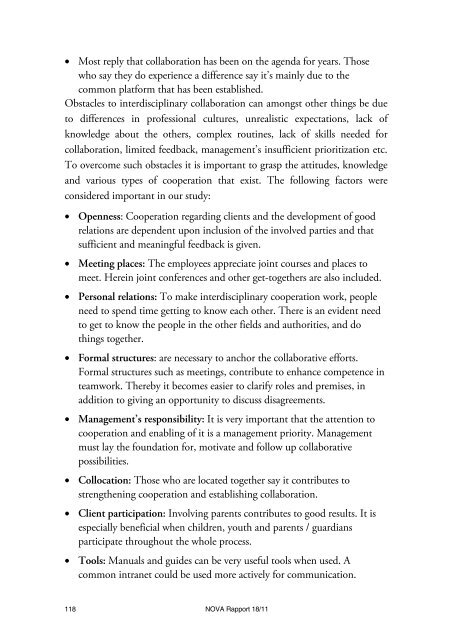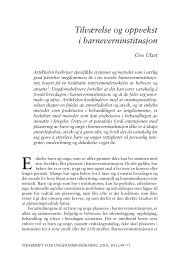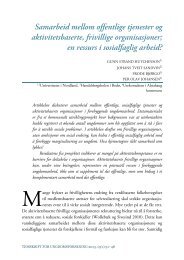NOVA Rapport 18/11
NOVA Rapport 18/11
NOVA Rapport 18/11
Create successful ePaper yourself
Turn your PDF publications into a flip-book with our unique Google optimized e-Paper software.
• Most reply that collaboration has been on the agenda for years. Those<br />
who say they do experience a difference say it’s mainly due to the<br />
common platform that has been established.<br />
Obstacles to interdisciplinary collaboration can amongst other things be due<br />
to differences in professional cultures, unrealistic expectations, lack of<br />
knowledge about the others, complex routines, lack of skills needed for<br />
collaboration, limited feedback, management’s insufficient prioritization etc.<br />
To overcome such obstacles it is important to grasp the attitudes, knowledge<br />
and various types of cooperation that exist. The following factors were<br />
considered important in our study:<br />
• Openness: Cooperation regarding clients and the development of good<br />
relations are dependent upon inclusion of the involved parties and that<br />
sufficient and meaningful feedback is given.<br />
• Meeting places: The employees appreciate joint courses and places to<br />
meet. Herein joint conferences and other get-togethers are also included.<br />
• Personal relations: To make interdisciplinary cooperation work, people<br />
need to spend time getting to know each other. There is an evident need<br />
to get to know the people in the other fields and authorities, and do<br />
things together.<br />
• Formal structures: are necessary to anchor the collaborative efforts.<br />
Formal structures such as meetings, contribute to enhance competence in<br />
teamwork. Thereby it becomes easier to clarify roles and premises, in<br />
addition to giving an opportunity to discuss disagreements.<br />
• Management’s responsibility: It is very important that the attention to<br />
cooperation and enabling of it is a management priority. Management<br />
must lay the foundation for, motivate and follow up collaborative<br />
possibilities.<br />
• Collocation: Those who are located together say it contributes to<br />
strengthening cooperation and establishing collaboration.<br />
• Client participation: Involving parents contributes to good results. It is<br />
especially beneficial when children, youth and parents / guardians<br />
participate throughout the whole process.<br />
• Tools: Manuals and guides can be very useful tools when used. A<br />
common intranet could be used more actively for communication.<br />
1<strong>18</strong><br />
<strong>NOVA</strong> <strong>Rapport</strong> <strong>18</strong>/<strong>11</strong>

















